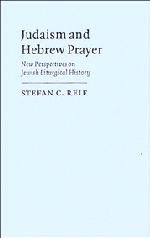Book contents
- Frontmatter
- Contents
- Preface
- 1 On Jewish liturgical research
- 2 The biblical inspiration
- 3 The early liturgy of the synagogue
- 4 Some liturgical issues in the talmudic sources
- 5 How the first Jewish prayer-book evolved
- 6 Authorities, rites and texts in the Middle Ages
- 7 From printed prayers to the spread of pietistic ones
- 8 The challenge of the modern world
- 9 A background to current developments
- Notes
- Select Bibliography
- Index of sources
- Index of prayers and rituals
- Index of names
- Index of subjects and rites
4 - Some liturgical issues in the talmudic sources
Published online by Cambridge University Press: 05 February 2015
- Frontmatter
- Contents
- Preface
- 1 On Jewish liturgical research
- 2 The biblical inspiration
- 3 The early liturgy of the synagogue
- 4 Some liturgical issues in the talmudic sources
- 5 How the first Jewish prayer-book evolved
- 6 Authorities, rites and texts in the Middle Ages
- 7 From printed prayers to the spread of pietistic ones
- 8 The challenge of the modern world
- 9 A background to current developments
- Notes
- Select Bibliography
- Index of sources
- Index of prayers and rituals
- Index of names
- Index of subjects and rites
Summary
INTRODUCTION
The situation with regard to Jewish liturgical history after the destruction of the Temple is in some respects in stark contrast to that which obtained in the periods of the Hebrew Bible and the Second Temple. In these earlier periods the researcher has to utilise a variety of sources that clearly emanate from different contexts and that have been brought together in the literature not because of their original significance and function but because of the way in which later generations chose to interpret and employ them. It is difficult, indeed unwise, to try to present the relevant texts as reflections of one systematic and consistent approach to matters of religion since their origin, history and provenance are very much open to debate. All that can be done (and it is hoped that this has been achieved in earlier chapters) is to identify certain characteristics, relate them speculatively to particular circles, and offer a broad description of the various types of liturgical expression that existed before rabbinic Judaism and Christianity carried the tradition forward in their separate ways. As with theology, so with liturgy, today's scholar prefers plurals to singulars in the description of past religious phenomena. It is safer to speak of biblical liturgies than of Jewish liturgy in the biblical period; similarly with regard to the era of the Second Temple.
- Type
- Chapter
- Information
- Judaism and Hebrew PrayerNew Perspectives on Jewish Liturgical History, pp. 88 - 121Publisher: Cambridge University PressPrint publication year: 1993



